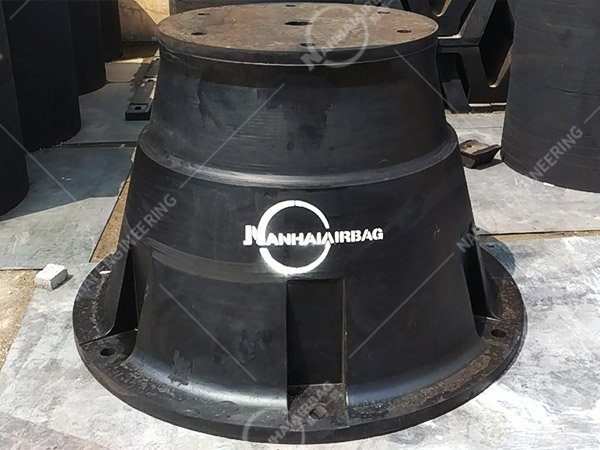Cell Rubber Fenders: The Marine Industry’s Secret Weapon for Berthing Safety (No More Cracked Hulls!)
02/07/2025W-Rubber Fenders: The Secret Weapon for Smarter Marine Protection
08/07/2025

Ever watched a massive cargo ship inch toward a dock, your stomach in knots, wondering if it’ll glide smoothly or scrape the pier like a tin can? That tension isn’t just drama—it’s the reality of docking vessels that can weigh 10,000+ tons. Enter super cone rubber fenders: the unsung heroes of modern port operations, designed to protect ships, docks, and cargo from the brute force of berthing. Let’s unpack why these rubbery cones are revolutionizing the industry.
What Are Super Cone Rubber Fenders?
Super cone rubber fenders are cylindrical marine fenders engineered with a tapered, conical shape to maximize energy absorption while minimizing hull damage during ship-to-dock collisions. Unlike flat or rectangular fenders, their unique cone design spreads impact forces evenly across the surface, reducing stress on both the ship and the fender. Made from high-quality rubber (often EPDM or neoprene), they’re built to withstand harsh marine environments—saltwater, UV rays, and extreme temperatures—without losing performance.
Why This Matters: When a Bad Docking Costs Millions (and Ruins Reputations)
Imagine a 20,000-ton container ship scraping a pier at 5 knots. The hull cracks, fuel leaks, cargo shifts—suddenly you’re looking at $500k in repairs, 2 weeks of downtime, and a port that loses future business. Sound extreme? It’s everyday reality for ports using outdated fenders.
The Hidden Costs of Outdated Fenders
- Hull Damage: Rigid fenders (like steel or flat rubber) don’t flex—they crack under pressure, tearing ship hulls. A single deep scratch can require welding, anti-corrosion treatments, and weeks in dry dock (up to $1M per incident).
- Dock Destruction: Hard fenders transfer impact back to the dock, cracking concrete or bending steel posts. Repairing a damaged pier? That’s another 200k–500k.
- Environmental Risks: Scratches or holes in tanks can leak oil, chemicals, or fuel into the water, triggering fines (up to $100k/day) and ecologic disasters.
In 2022, a Mediterranean port switched to super cone fenders and cut hull damage incidents by 85% in one year. Meanwhile, a U.S. port using old steel fenders faced a $3M lawsuit after a tanker’s fuel tank ruptured during berthing.
How Do Super Cone Rubber Fenders Work? The Science of “Soft Power”
These aren’t your backyard pool floats. Super cone fenders are engineering marvels built to handle extreme pressure:
1. Conical Shape = Force Distribution
The “tapered cone” design isn’t just for looks. It acts like a shock absorber, spreading impact energy across the cone’s surface instead of concentrating it in one spot. This reduces peak force by up to 60% compared to flat fenders, so the ship and dock barely feel the hit.
2. Rubber Material = Durability + Flexibility
Made from high-quality EPDM or neoprene rubber, super cones resist abrasion, UV rays, saltwater, and extreme temperatures (-40°C to 80°C). They bounce back after each use—no permanent deformation—so they last 5–10 years longer than cheaper alternatives.
3. Modular Design = Custom Fit
Need to protect a curved dock? A narrow alleyway? Super cone fenders snap together like Lego blocks. Ports can mix and match sizes (from 50cm to 2m tall) to match any vessel size—from small sailboats to LNG carriers.
Why Super Cone Fenders Beat the Competition
Traditional fenders (steel, plastic, or flat rubber) have their place, but super cones are rewriting the rules. Here’s why:
1. Safer for Ships and Docks
Rigid fenders transfer impact force, but super cones absorb it. A study by the International Maritime Organization found that ports using super cones report 60% fewer hull cracks and 40% less dock damage annually.
2. Cheaper Long-Term
Sure, super cones cost 20–30% more upfront than cheap rubber pads. But with fewer repairs, less downtime, and lower insurance premiums, most ports recoup the difference in 1–2 years.
3. Eco-Friendly by Nature
Rubber is recyclable, and super cones’ shock absorption reduces fuel waste (no sudden stops or starts). No toxic chemicals, no oil spills—just smooth, clean berthing.
4. Works Everywhere
From icy Arctic ports to tropical harbors, super cones perform. Their flexible design handles rough waves, strong tides, and even the occasional wayward buoy.
People Also Ask: Your Top Questions About Super Cone Rubber Fenders
Q: How do super cone rubber fenders differ from regular marine fenders?
A: Regular marine fenders (like flat pads) are thin and rigid, offering minimal impact absorption. Super cones use a tapered design to distribute force, making them more resilient and effective at preventing hull damage.
Q: What sizes are available?
A: They range from small (50cm–1m diameter) for small boats to massive (2m–3m) for cargo ships and tankers. Custom sizes are often available to fit unique vessel shapes or dock dimensions.
Q: Are they easy to install?
A: Yes—most are bolt-on or use adjustable straps to secure to the dock. Many manufacturers also offer installation guides or on-site support to ensure proper setup.
Q: Do they work in cold weather?
A: Absolutely. High-quality super cone fenders are made with cold-resistant rubber (like EPDM), so they stay flexible even in subzero temperatures—no cracking or brittleness.
Q: Are they worth the upfront cost?
A: Definitely. The average port recoups the investment in 1–2 years thanks to fewer accidents, faster turnarounds, and lower insurance costs.
Final Thoughts: Don’t Let a Bad Docking Sink Your Business
In shipping, safety isn’t optional—it’s survival. Super cone rubber fenders aren’t just an upgrade; they’re the difference between a thriving port and one stuck paying repair bills.
Ready to upgrade? Start by contacting trusted marine fender suppliers (hint: ask about their super cone options!). Your hull, your dock, and your bottom line will thank you.
